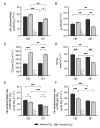Impact of Plant Developmental Stage on Photosynthetic Acclimation to Elevated [CO2] in Durum Wheat
- PMID: 40733461
- PMCID: PMC12299461
- DOI: 10.3390/plants14142224
Impact of Plant Developmental Stage on Photosynthetic Acclimation to Elevated [CO2] in Durum Wheat
Abstract
The response of plants to elevated atmospheric [CO2] is highly dynamic and influenced by developmental stage, yet its role in photosynthetic acclimation remains underexplored. This study examines the physiological and molecular responses of wheat (Triticum durum, var. Amilcar) to elevated [CO2] (700 ppm vs. 400 ppm) at two distinct developmental stages: the vegetative stage at the end of the elongation stage and the reproductive stage at the beginning of ear emergence (Z39 and Z51, respectively). Wheat plants at the developmental stage Z39, cultivated under elevated [CO2], maintained photosynthetic rates despite a carbohydrate build-up. However, at Z51, photosynthetic acclimation became more evident as the decline in Rubisco carboxylation capacity (Vcmax) persisted, but also stomatal conductance and diffusion were decreased. This was accompanied by the up-regulation of the CA1 and CA2 genes, likely as a compensatory mechanism to maintain CO2 supply. Additionally, hormonal adjustments under elevated [CO2], including increased auxin and bioactive cytokinins (zeatin and isopentenyl adenine), may have contributed to delayed senescence and nitrogen remobilization, sustaining carbon assimilation despite biochemical constraints. These findings highlight the developmental regulation of photosynthetic acclimation, emphasizing the need for the stage-specific assessments of crop responses to future atmospheric conditions.
Keywords: carbohydrates; elevated [CO2]; nitrogen; photosynthetic acclimation; phytohormones.
Conflict of interest statement
The authors declare that the research was conducted in the absence of any commercial, financial or personal relationships that could be construed as a potential conflict of interest.
Figures






Similar articles
-
Effects of atmospheric CO2 concentration on transpiration and leaf elongation responses to drought in Triticum aestivum, Lolium perenne and Festuca arundinacea.Ann Bot. 2024 Nov 13;134(5):787-802. doi: 10.1093/aob/mcae114. Ann Bot. 2024. PMID: 39086357 Free PMC article.
-
Data on transgenerational memory effects of photosynthetic efficiency of twelve wheat varieties under elevated carbon dioxide concentration and reduced soil water availability.Data Brief. 2025 Apr 9;60:111545. doi: 10.1016/j.dib.2025.111545. eCollection 2025 Jun. Data Brief. 2025. PMID: 40534714 Free PMC article.
-
Investigating photosynthetic and chlorophyll fluorescence responses to light in peanut acclimated to elevated CO2 and temperature.Photosynth Res. 2025 May 14;163(3):29. doi: 10.1007/s11120-025-01151-8. Photosynth Res. 2025. PMID: 40366484
-
The Black Book of Psychotropic Dosing and Monitoring.Psychopharmacol Bull. 2024 Jul 8;54(3):8-59. Psychopharmacol Bull. 2024. PMID: 38993656 Free PMC article. Review.
-
A rapid and systematic review of the clinical effectiveness and cost-effectiveness of paclitaxel, docetaxel, gemcitabine and vinorelbine in non-small-cell lung cancer.Health Technol Assess. 2001;5(32):1-195. doi: 10.3310/hta5320. Health Technol Assess. 2001. PMID: 12065068
References
-
- IPCC . In: Climate Change 2022: Impacts, Adaptation and Vulnerability. Pörtner H.-O., Roberts D.C., Tignor M., Poloczanska E.S., Mintenbeck K., Alegría A., Craig M., Langsdorf S., Löschke S., Möller V., et al., editors. Cambridge University Press; Cambridge, UK: New York, NY, USA: 2022. 3056p. Contribution of Working Group II to the Sixth Assessment Report of the Intergovernmental Panel on Climate Change. - DOI
-
- Ainsworth E.A., Rogers A., Nelson R., Long S.P. Testing the “Source-Sink” Hypothesis of down-Regulation of Photosynthesis in Elevated [CO2] in the Field with Single Gene Substitutions in Glycine Max. Agric. For. Meteorol. 2004;122:85–94. doi: 10.1016/j.agrformet.2003.09.002. - DOI
Grants and funding
LinkOut - more resources
Full Text Sources
Miscellaneous

